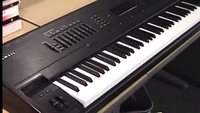User:Neo Te Aika/Audio Production Notes/Synthesizers of Halo
From Halopedia, the Halo wiki
Overview
This page aims to provide specific details of the synthesizers and audio instrument equipment used on Halo.
Below is an image gallery of equipment being unpacked and set up as Bungie settled into their Seattle office in 2001.
E-MU Emulator
The Emulators are a family of samplers produced by E-MU Systems that provided access to play back high-quality sample libraries. Total Audio used at least two models of the fourth-generation of Emulator samplers, one model was owned during the development of Myth/Myth II but was destroyed by a fire that ravaged the studio during early 1999. Around the time that Bungie was acquired by Microsoft, an upgraded E4XT Ultra model was purchased, and set up in the audio studio in Bungie's Seattle office.
Emulators primarily loaded sound programs from floppy diskettes, or over SCSI based devices like a hard disk drive or CD-ROM. The higher-tier packages such as the E4XT Ultra included expanded memory and internal capabilities, along with several sound libraries authored by E-MU themselves, distributed with the sampler as a package of compact discs. The official discs distributed with the Emulator IV generation of samplers were used in the production of Halo: Combat Evolved.
E-MU Proteus
The Proteus synthesizers are a series of compact, 1U-rack-mount devices with onboard select sound libraries comprised from the larger internal sample collections produced by E-MU for their Emulator samplers, and are essentially a "locked down" Emulator III sampler with a preset memory of sounds. While they do not directly have onboard FX processors, or the ability to sample new sounds directly, several models were released with different selections of sounds.
The original Proteus was aimed at contemporary pop/rock sounds, the Proteus 2 focused on orchestral and ensemble programs, and the Proteus 3 contained a variety of sounds with a collection of ethnic and eastern-world samples. Along with the main three models, several additional revisions were produced from 1989-1995. Each main Proteus unit was available in an 'XR' model that increased the onboard memory to accommodate additional factory and user sounds, a variant of the Proteus 1 known as the Proteus Plus Orchestral appended the second model's orchestral sounds into the first as one complete package, and an additional third-party model was available for some time, produced by InVision, known as the ProtoLogic.
This first-generation of Proteus synthesizers were dominant throughout the video game music productions of Total Audio, and appear in Riven, Myth, Myth II, Septerra Core and were used on Halo within the production of the original Halo theme. Eventually an expansion kit for the Proteus 2000 was released, known as Protozoa, which included all of the factory sounds from all three original Proteus models, which went on to replace the original models for the later production of Halo's soundtrack.
E-MU Procussion
After the success of the main three Proteus synthesizers, the Procussion was created, effectively a fourth member of the family that focused on drum and percussion instruments.
Unlike the former three Proteus units that would have their sounds live on through future products, the Procussion's internal sounds have never fully materialized in any other form outside of the original hardware. Some samples from the Procussion exist on libraries available for Emulator samplers, but they share only the base samples, instead opting to create all-new and different sounds from the same libraries. Due to this, the original Procussion hardware currently remains the only genuine source of some of the signature drum sounds heard within Myth, Myth II, Halo and Halo 2.
E-MU Proteus 2000
The Proteus 2000 served as a successor architecture to both the original Proteus sounds, and a product launched the previous year focused on electronic synthesizer sounds, known as the Audity 2000. The Proteus 2000 expanded on the intent behind the original Proteus products, providing a vast package of contemporary and multi-genre sounds from E-MU's internal libraries as created for their Emulator samplers, exchanging the ability to sample new sounds for a compact unit that could be expanded with multiple expansion boards, according to whatever sounds the user saw interest in using. Where the first-generation Proteus synthesizers were based on the Emulator III architecture, the Proteus 2000 is derived from the technology behind the Emulator IV samplers, and features additional functions and processing abilities that were introduced with the Emulator IV.
Various packages existed for the Proteus 2000 architecture, each focused on different sounds, but unlike the first-generation models, their internal sounds were on a removable ROM chip that was interchangeable between devices. The Proteus 2000 used in the Halo series included the standard Composer ROM typically included with new Proteus 2000 synths, and the Protozoa expansion ROM that included all sounds from the original generation of Proteus synthesizers.
Kurzweil K2500
 This article is a stub. You can help Halopedia by expanding it.
This article is a stub. You can help Halopedia by expanding it.
Roland JD-990
 This article is a stub. You can help Halopedia by expanding it.
This article is a stub. You can help Halopedia by expanding it.
Roland XV-5080
 This article is a stub. You can help Halopedia by expanding it.
This article is a stub. You can help Halopedia by expanding it.
External links
- https://odysseyaudio.org/spreadsheet (Odyssey Audio Spreadsheet)



